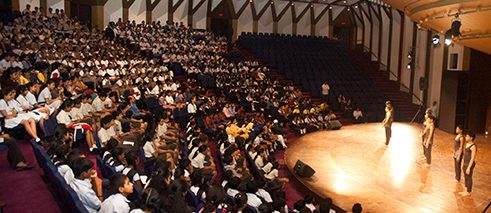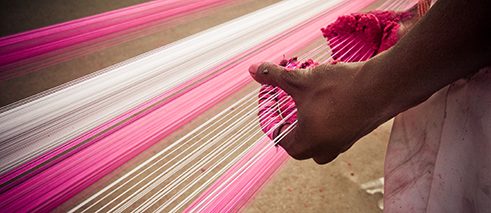Artist residencies
Solidarity and Reflexivity

Uncovering your ideas and strategies in developing your arts management skills, exposing your vulnerabilities in building a bigger dream, weaving the threads that binds one into a tighter, stronger network - all this and more is what ARThink South Asia Fellowship and Residency gave Rashmi Dhanwani. Here she charts her journey.
A few weeks ago, Vikram Iyengar, Co-founder and Artistic Director of the performance company, Ranan, and a former ARThink South Asia (ATSA) Fellow, shared a Ministry of Culture link requesting “comments from public on the Draft document on proposed National Mission on Intangible Cultural Heritage of India”. A critical document that outlines not just the discussions and agenda setting processes at play, but also traces the evolution of this document to its present stage. Such public declarations, usually unpublicised, often go unnoticed. Sharing of such content occurs within certain arts networks in the country, especially those that concern themselves with public funding for culture, run arts institutions, and who are directly impacted by such documents—a small number, that may not include a young arts manager building a portfolio career.
Being a part of the same network of ATSA fellows, I scanned Iyengar’s post. It was shared on a highly popular social networking group for arts opportunities, exposing many more arts professionals to the document exhorting them to send in comments. View the process from the top, and you can see movement of information and knowledge spread from those within a relatively structured network to those outside of it. Fellowships like ATSA generate a crucial pathway into harnessing the strength of informal networks, while also endorsing the importance of structure in an increasingly compartmentalised arts sector in India.
Not too long ago, I was a part of one fragment of this compartment, marooned in a mammoth arts institution and questioning the audience accessibility gap. It was in an attempt to delve into the reasons for this gap and the desire to bridge it that triggered the idea for a project on cultivating the ‘Rasika (aesthete)’ – an audience building initiative for classical arts at the National Centre for the Performing Arts (NCPA) in Mumbai. The ARThink South Asia Fellowship that was awarded for this project in 2011, transformed my practice in more ways than one:
The Project and Professional Development
 Dance demonstration with Astaad Deboo
| Photo: © Astad Deboo
The Fellowship enabled the project to grow in scope during the course of the fortnight’s residency. By the end of the Fellowship in 2012, we had started NCPA’s first outreach department with a team of two people to manage the initiatives, connected with several schools and colleges, collaborated with youth festivals, developed a range of online and offline engagement initiatives, initiated audience data tracking, and developed an outreach component for every NCPA festival leading to student shows, introductory ‘Chalk talks’, and access-based workshops. The attempt made to seed outreach into organisational thinking and strategy was reasonably successful, as the activities of the department were subsumed into the existing departmental frameworks. Elements from the project continue to be used even two years after I left the organisation.
Dance demonstration with Astaad Deboo
| Photo: © Astad Deboo
The Fellowship enabled the project to grow in scope during the course of the fortnight’s residency. By the end of the Fellowship in 2012, we had started NCPA’s first outreach department with a team of two people to manage the initiatives, connected with several schools and colleges, collaborated with youth festivals, developed a range of online and offline engagement initiatives, initiated audience data tracking, and developed an outreach component for every NCPA festival leading to student shows, introductory ‘Chalk talks’, and access-based workshops. The attempt made to seed outreach into organisational thinking and strategy was reasonably successful, as the activities of the department were subsumed into the existing departmental frameworks. Elements from the project continue to be used even two years after I left the organisation.Contemporary Dancer Astaad Deboo and his troupe interact with school students at a dance demonstration organised by the NCPA
Professionally, I developed skills in project management, strategic planning, financial planning and management, insight into significant legal issues, and a keen perspective on policy development—approaches that I continue to use today.
Networks
 School Children interacting with Astad Deboo and his troop after his work is presented at NCPA
| Photo: © Astad Deboo
Arts Management is a relatively new discipline, with one of earliest scientific conferences only being organised in 1991 (International Conference on Arts and Cultural Management). In India the landscape is relatively sparse, where only a couple of arts management diplomas around. In terms of training, most arts professionals in the sector occupy opposing ends of the spectrum: they either have some relevant degree from a University abroad or absolutely no formal training in arts management from India. Consequently, network building in the arts sector is rarely institutional and more informal than most other sectors. Whatever exists, exists in compartmentalised pockets: with the visual arts, theatre, dance, music genres having their own grammar of networks, connections and information exchange.
School Children interacting with Astad Deboo and his troop after his work is presented at NCPA
| Photo: © Astad Deboo
Arts Management is a relatively new discipline, with one of earliest scientific conferences only being organised in 1991 (International Conference on Arts and Cultural Management). In India the landscape is relatively sparse, where only a couple of arts management diplomas around. In terms of training, most arts professionals in the sector occupy opposing ends of the spectrum: they either have some relevant degree from a University abroad or absolutely no formal training in arts management from India. Consequently, network building in the arts sector is rarely institutional and more informal than most other sectors. Whatever exists, exists in compartmentalised pockets: with the visual arts, theatre, dance, music genres having their own grammar of networks, connections and information exchange.These networks assume a more critical role for professional development within the arts sector. As Eleanor Shaw[1] (2006) notes, all networks contain information, advice and economic transactions. It is these transactions that are augmented by relationship dynamics of friendships and trust-based relationships within those networks. In a project-driven environment, reliability and recommendation become crucial normative elements of building artistic work—be it a performance, project or a festival.
In a sector devoid of major alumni based networks or cross-genre interactions, a young arts manager faces significant challenges in grasping the big picture of the sectoral changes or even getting access to the right information. In this light, a programme like ATSA has played in creating cohesion of professional solidarity in an otherwise dispersed sector in a country as culturally diverse as India. Over the years, I have relied on my cohort for advice, information and support. The knowhow of their projects and their management strategies, and being privy to challenges in the development of their own journeys, have significantly impacted my own growth within the sector. As recently as last month, I was guided by one of my cohort while developing an arts project proposal for an international charity.
Additionally, access to networks enable sound boarding, verification of decisions in line with key policy documents, exposure to multiple information sources that enable triangulation of data, opening up of project opportunities, and help generate sound, wholesome decisions.
Reflexivity
 Power Lines
| Photo: © Devansh Jhaveri
The ATSA fellowship created room for reflection in my practice. Connecting arts management to self-reflexivity isn’t an entirely new approach. In fact, this approach has impacted the larger discourse around effective management. As Peter Senge (1990)[2] noted, effective management in the early 80s came to be associated with developed of self-reflective practices by which one’s assumptions, identity and values are frequently re-thought.
Power Lines
| Photo: © Devansh Jhaveri
The ATSA fellowship created room for reflection in my practice. Connecting arts management to self-reflexivity isn’t an entirely new approach. In fact, this approach has impacted the larger discourse around effective management. As Peter Senge (1990)[2] noted, effective management in the early 80s came to be associated with developed of self-reflective practices by which one’s assumptions, identity and values are frequently re-thought.In the context of Project Rasika, the fellowship allowed me to question the motives behind audience building for an institution and how it aligns and intersects with the broader cultural sector. “No culture is sustained much less advanced by such a poor audience,” wrote columnist Aakar Patel, and drives home a crucial point about arts management: that to be an arts manager, you need to critically engage with both the sector and your place in it. I used the space to outline how my work could make a difference both to the institution and to the sector at large. Academic Hilary Glow (2010)[3] identifies one of the future challenges of arts management i.e. to take a critical approach to the conventional discourses of arts marketing in order to deliver a new focus on audience engagement. That helped strengthen the project, while also giving me the confidence in my own ability to deliver.
Over the years, reflexivity has also helped inject passion and a dynamism in my project plans, stemming from a confidence of having engaged with my approach on a much deeper level. Assumptions are questioned, convictions verified, and impact envisioned — the courage of conviction is aligned with a critical approach to management. Together with access to networks, the ATSA Fellowship has helped me develop a holistic approach to arts management and helped nuture my growth as an arts professional.
[1] Shaw, Eleanor. "Small firm networking an insight into contents and motivating factors." International Small Business Journal 24.1 (2006): 5-29.
[2] Senge, Peter M. "The fifth discipline: The art and practice of the learning organization." New York: Currency Doubleday (1990).
[3] Glow, Hilary. "Taking a critical approach to arts management." Asia Pacific journal of arts & cultural management 7.2 (2010): 585-594.